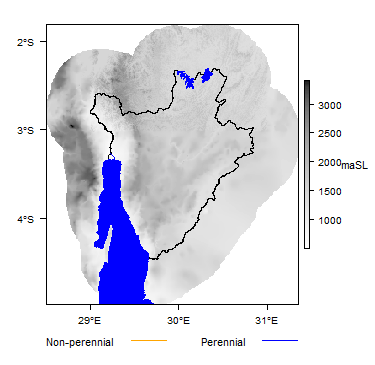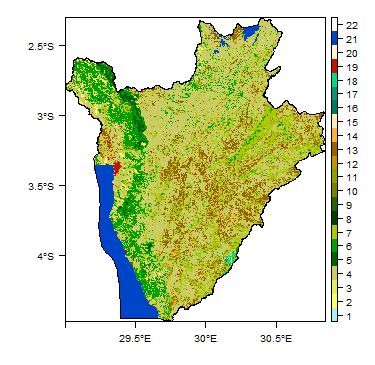Hydrogeology of Burundi: Difference between revisions
No edit summary |
No edit summary |
||
| Line 9: | Line 9: | ||
'''Dr Kirsty Upton''' and '''Brighid Ó Dochartaigh''', British Geological Survey, UK | '''Dr Kirsty Upton''' and '''Brighid Ó Dochartaigh''', British Geological Survey, UK | ||
Please cite this page as: Upton | Please cite this page as: Upton and Ó Dochartaigh, 2016. | ||
Bibliographic reference: Upton, K | Bibliographic reference: Upton, K, and Ó Dochartaigh, B É. 2016. Africa Groundwater Atlas: Hydrogeology of Burundi. British Geological Survey. Accessed [date you accessed the information]. http://earthwise.bgs.ac.uk/index.php/Hydrogeology_of_Burundi | ||
==Terms and conditions== | ==Terms and conditions== | ||
| Line 17: | Line 17: | ||
The Africa Groundwater Atlas is hosted by the British Geological Survey (BGS) and includes information from third party sources. Your use of information provided by this website is at your own risk. If reproducing diagrams that include third party information, please cite both the Africa Groundwater Atlas and the third party sources. Please see the [[Africa Groundwater Atlas Terms of Use | Terms of use]] for more information. | The Africa Groundwater Atlas is hosted by the British Geological Survey (BGS) and includes information from third party sources. Your use of information provided by this website is at your own risk. If reproducing diagrams that include third party information, please cite both the Africa Groundwater Atlas and the third party sources. Please see the [[Africa Groundwater Atlas Terms of Use | Terms of use]] for more information. | ||
==Geographical | ==Geographical setting== | ||
[[File:Burundi_Political.png | right | frame | Burundi. Map developed from USGS GTOPOPO30; GADM global administrative areas; and UN Revision of World Urbanization Prospects. For more information on the datasets used to develop the map see the [[Geography | geography resource page]])]] | [[File:Burundi_Political.png | right | frame | Burundi. Map developed from USGS GTOPOPO30; GADM global administrative areas; and UN Revision of World Urbanization Prospects. For more information on the datasets used to develop the map see the [[Geography | geography resource page]])]] | ||
| Line 25: | Line 25: | ||
{| class = "wikitable" | {| class = "wikitable" | ||
|- | |- | ||
|Estimated | |Estimated population in 2013* || 10 162 532 | ||
|- | |- | ||
|Rural | |Rural population (% of total) (2013)* || 88.5% | ||
|- | |- | ||
|Total | |Total surface area* || 25 680 sq km | ||
|- | |- | ||
|Agricultural | |Agricultural land (% of total area) (2012)* || 75.3% | ||
|- | |- | ||
|Capital | |Capital city || Bujumbura | ||
|- | |- | ||
|Region || Eastern/Central Africa | |Region || Eastern/Central Africa | ||
|- | |- | ||
|Border | |Border countries || Rwanda, Tanzania, the Democratic Republic of the Congo to the west | ||
|- | |- | ||
|Annual | |Annual freshwater withdrawal (2013)* || 288 million cubic metres | ||
|- | |- | ||
|Annual | |Annual freshwater withdrawal for agriculture (2013)* || 77.1% | ||
|- | |- | ||
|Annual | |Annual freshwater withdrawal for domestic use (2013)* || 17% | ||
|- | |- | ||
|Annual | |Annual freshwater withdrawal for industry (2013)* || 5.9% | ||
|- | |- | ||
|Rural | |Rural population with access to improved water source (2012)* || 73.2% | ||
|- | |- | ||
|Urban | |Urban population with access to improved water source (2012)* || 91.5% | ||
|} | |} | ||
| Line 64: | Line 64: | ||
</gallery> | </gallery> | ||
[[File:Burundi_pre_Monthly.png| 255x124px| Average monthly precipitation for Burundi showing minimum and maximum (light blue), 25th and 75th percentile (blue), and median (dark blue) rainfall]] [[File:Burundi_tmp_Monthly.png| 255x124px| Average monthly temperature for Burundi showing minimum and maximum (orange), 25th and 75th percentile (red), and median (black) temperature]] [[File:Burundi_pre_Qts.png | 255x124px | Quarterly precipitation over the period 1950-2012]] [[File:Burundi_pre_Mts.png|255x124px | Monthly precipitation (blue) over the period 2000-2012 compared with the long term monthly average (red)]] | [[File:Burundi_pre_Monthly.png| 255x124px| Average monthly precipitation for Burundi showing minimum and maximum (light blue), 25th and 75th percentile (blue), and median (dark blue) rainfall]] [[File:Burundi_tmp_Monthly.png| 255x124px| Average monthly temperature for Burundi showing minimum and maximum (orange), 25th and 75th percentile (red), and median (black) temperature]] [[File:Burundi_pre_Qts.png | 255x124px | Quarterly precipitation over the period 1950-2012]] [[File:Burundi_pre_Mts.png|255x124px | Monthly precipitation (blue) over the period 2000-2012 compared with the long-term monthly average (red)]] | ||
| Line 106: | Line 106: | ||
| [[File:Burundi_Geology.png | thumb| 500px| Geology of Burundi at 1: | | [[File:Burundi_Geology.png | thumb| 500px| Geology of Burundi at 1:5 million scale. Developed from USGS map (Persits et al., 2002). For For more information on how the map was developed see the [[Geology | geology resource page]])]] | ||
|} | |} | ||
| Line 115: | Line 115: | ||
More information on the hydrogeology of Burundi is available in the report [http://www.bgs.ac.uk/africagroundwateratlas/fulldetails.cfm?id=AGLA060003 UN (1988)] (see References section, below). | More information on the hydrogeology of Burundi is available in the report [http://www.bgs.ac.uk/africagroundwateratlas/fulldetails.cfm?id=AGLA060003 UN (1988)] (see References section, below). | ||
[[File:Burundi_Hydrogeology.png| 500px|thumb|center| Hydrogeology of Burundi at 1: | [[File:Burundi_Hydrogeology.png| 500px|thumb|center| Hydrogeology of Burundi at 1:5 million scale. For more information on how the map was developed see the [[Hydrogeology Map | hydrogeology map resource page]]]] | ||
[[File: Hydrogeology_Key.png | center| 500x195px]] | [[File: Hydrogeology_Key.png | center| 500x195px]] | ||
Revision as of 15:04, 11 August 2016
Africa Groundwater Atlas >> Hydrogeology by country >> Hydrogeology of Burundi
This page has limited information and needs to be updated. If you have more information on the hydrogeology of Burundi, please get in touch!
Compilers
Dr Kirsty Upton and Brighid Ó Dochartaigh, British Geological Survey, UK
Please cite this page as: Upton and Ó Dochartaigh, 2016.
Bibliographic reference: Upton, K, and Ó Dochartaigh, B É. 2016. Africa Groundwater Atlas: Hydrogeology of Burundi. British Geological Survey. Accessed [date you accessed the information]. http://earthwise.bgs.ac.uk/index.php/Hydrogeology_of_Burundi
Terms and conditions
The Africa Groundwater Atlas is hosted by the British Geological Survey (BGS) and includes information from third party sources. Your use of information provided by this website is at your own risk. If reproducing diagrams that include third party information, please cite both the Africa Groundwater Atlas and the third party sources. Please see the Terms of use for more information.
Geographical setting

General
| Estimated population in 2013* | 10 162 532 |
| Rural population (% of total) (2013)* | 88.5% |
| Total surface area* | 25 680 sq km |
| Agricultural land (% of total area) (2012)* | 75.3% |
| Capital city | Bujumbura |
| Region | Eastern/Central Africa |
| Border countries | Rwanda, Tanzania, the Democratic Republic of the Congo to the west |
| Annual freshwater withdrawal (2013)* | 288 million cubic metres |
| Annual freshwater withdrawal for agriculture (2013)* | 77.1% |
| Annual freshwater withdrawal for domestic use (2013)* | 17% |
| Annual freshwater withdrawal for industry (2013)* | 5.9% |
| Rural population with access to improved water source (2012)* | 73.2% |
| Urban population with access to improved water source (2012)* | 91.5% |
* Source: World Bank
Climate
These maps and graphs were developed from the CRU TS 3.21 dataset produced by the Climatic Research Unit at the University of East Anglia, UK. For more information see the climate resource page.
-
Koppen Geiger Climate Zones
-
Average Annual Precipitation
-
Average Temperature
Surface water
|
|
 |
Soil
 |
Land cover
 |
Geology
The geology map shows a simplified version of the geology at a national scale. More information is available in the report UN (1988) (see References section, below).
|
|
 |
Hydrogeology
The hydrogeology map below shows a simplified version of the type and productivity of the main aquifers at a national scale (see the hydrogeology Map resource page for more details).
More information on the hydrogeology of Burundi is available in the report UN (1988) (see References section, below).


Groundwater use and management
Groundwater is used mainly in certain regions.
There is a database which in 2009 had limited information about groundwater sources. A GTZ-supported project included work to develop a central database at the national water authority.
Transboundary aquifers
For further information about transboundary aquifers, please see the Transboundary aquifers resources page
References
References with more information on the geology and hydrogeology of Burundi can be accessed through the Africa Groundwater Literature Archive.
United Nations. 1989. Groundwater in Eastern, Central and Southern Africa: Burundi. United Nations Department of Technical Cooperation for Development.
Return to the index pages
Africa Groundwater Atlas >> Hydrogeology by country >> Hydrogeology of Burundi






